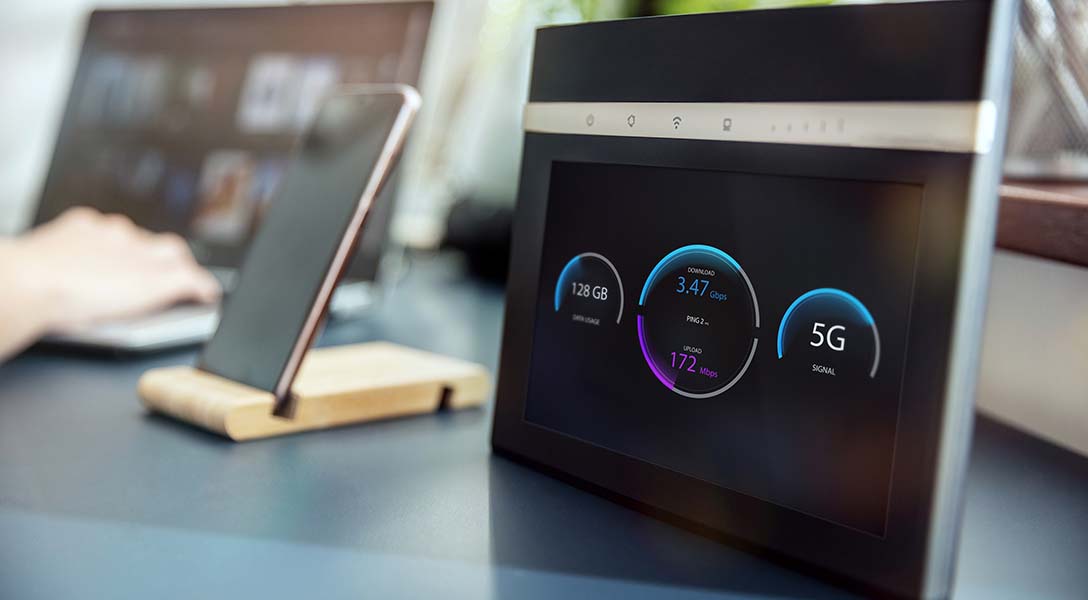
Texas, Louisiana and New Mexico laying groundwork for greater internet connectivity
The digital inclusion landscape, Part 1
The internet has transformed the way we live and work, and with this transformation has come widespread discussion among policymakers and community leaders about achieving digital inclusion and narrowing the digital divide.
Digital inclusion took on new urgency in the U.S. when the COVID-19 pandemic thrust the issue into the spotlight, forcing schools, governments and businesses to expedite the move online. While broadband access is necessary to fully participate in society and the economy today, it’s not available or affordable for many. The costs of having inadequate access—or no internet at all—can be high, limiting opportunities for success, educational achievement, positive health outcomes, social inclusion and civic engagement, according to the Digital Equity Act of 2021. The act seeks to promote digital literacy and access, establishing the State Digital Equity Capacity Grant Program to help communities advance telecommunications capabilities.In this first article in a series on digital inclusion, we document the level of digital connectivity in 2022 in the Federal Reserve’s Eleventh District—Texas, northern Louisiana and southern New Mexico. We find that while the digital divide is wide in poor and more isolated areas of the states, concerted efforts are taking shape across the region to close it. We document some of the ongoing public efforts to improve digital inclusion in the Eleventh District, including the Affordable Connectivity Program (ACP) and the Digital Navigator program specific to Louisiana.
Digital inclusion and equity programs
Digital inclusion refers to the activities necessary to ensure that all people and communities, including the most disadvantaged, have access to and use of information and communication technologies. The digital divide refers to the gap between those who have the access, skills and support for effective online engagement and those who do not.
The Digital Equity Act asserts that digital exclusion exacerbates wealth and income gaps and that addressing it will require additional, ongoing investment and research. Inadequate infrastructure has been noted in areas of low population density; internet providers receive less return on investment for bringing service to these areas.
By providing communities better access to the internet, digital inclusion initiatives seek to help communities bridge the divide. We examine the geographic coverage of the Affordable Connectivity Program, which is available in all three states, and discuss Louisiana’s Digital Navigator program. Further, we provide information on broadband speed at the census-tract level.
The Affordable Connectivity Program is designed to help lower-income families achieve reliable digital access, whether it’s help with purchasing devices or paying the monthly cost of Wi-Fi. A government program run by the Federal Communications Commission, the ACP was funded in November 2021 by the Infrastructure Investment and Jobs Act.
Louisiana’s Digital Navigator program is run by ConnectLA, the state’s broadband office. This program provides information and support to parishes and municipalities as they establish local leadership that’s informed about the impact and benefit of broadband infrastructure. These navigators are, ideally, local government leaders who have “the authority to make official requests of local government departments, believe in and can clearly articulate why the community needs better broadband, and can help educate elected officials on the value of universal broadband,” according to the program’s website.
Assessing digital inclusion by state
Connection quality, cost and accessibility are factors in determining whether broadband in a market is adequate to support digital equity. When it comes to internet infrastructure, download speed is often a measure of the quality of service in the area. We use 25 megabits per second (Mbps) as the lowest benchmark for functional internet in this report, though most homes require much faster speeds for multiple devices. Data are based on a unique internet speed dataset from the Ookla Speedtest (see the sidebar “Clocking internet speeds: What is sufficient?” for detail on calculating speeds).
Texas
Most Texas tracts can meet the functional internet benchmark: Over 99 percent have a download speed of at least 25 Mbps on average, while fewer than 89 percent meet the quality benchmark that a typical modern household needs at 100 Mbps download/20 Mbps upload (Chart 1).

In the chart, less-populous Texas tracts have a lower share of households meeting the speed benchmark. The same is true when focusing on the metros. In DFW, for example, outlying tracts and more economically disadvantaged areas like southern Dallas have the lowest-quality broadband coverage (Chart 2).
Urban centers still fare better: 0.1 percent of DFW tracts don’t have 25 Mbps on average, and 3.0 percent of DFW tracts don’t meet the greater, 100 Mbps download standard.
Despite having better internet quality compared with rural areas, urban areas face their own broadband challenges. Instead of internet infrastructure barriers, households in low-income urban neighborhoods may struggle with costs beyond the service itself, including devices and maintenance.
The Affordable Connectivity Program is helping some areas get and stay connected. Chart 3 shows which parts of Texas have taken advantage of the program so far. Darker blue tracts, seen mostly around larger cities, represent greater adoption.

More than 1.4 million Texas households had signed up for the ACP as of the end of May 2023, or over 13 percent of state households. However, current ACP guidelines allow for households 200 percent or more under the poverty line to qualify for some level of subsidy. This can include many more households—up to 19 percent of Texas’ population, according to the latest American Community Survey data.
So far, most ACP subscribers are those for whom issues of connectivity are about affordability rather than infrastructure.
Louisiana
Louisiana, like Texas, has made strides in digital access over the past decade but is still working on improving both internet infrastructure and affordability.
Most of Louisiana’s tracts—99 percent—meet the 25 Mbps benchmark for download speeds (Chart 4). Eighty-five percent of the tracts meet the 100 Mbps download-speed standard, a similar proportion to Texas’ tracts. Those areas with slower speeds are also in the less-populous parts of the state, where service providers have less incentive to operate.

To improve access within the state, ConnectLA has initiated the Digital Navigator program. Started in spring 2022, the program is in its early stages. On the parish level, it has reached out to the parts of the state illustrated in blue in Chart 5.

The program empowers local leaders to make inroads within their communities and coalesce stakeholders to effectively use federal grant dollars to improve the internet infrastructure in their parish. Its goal is to reach the communities with the greatest need and slowest internet speeds.

Chart 6 shows a wider distribution for tracts in the Digital Navigator program as of November 2022, meaning that more tracts had slower download speeds and fewer had faster download speeds than areas not in the program. On average, tracts with navigators also had slower upload speeds and increased latency (the milliseconds it takes to move data from a local computer to the broader network and back). Notably, while about 13.5 percent of tracts without navigators did not meet the 100 Mbps download-speed threshold, 25.3 percent of tracts with navigators failed to meet that threshold. These data from the program’s infancy indicate that navigators are in the tracts that can benefit the most.
Much like Texas, however, Louisiana struggles with internet cost barriers along with infrastructure ones. One-quarter (25.6 percent) of all Louisianans are income-qualified for the Affordable Connectivity Program. As of the end of May 2023, more than 440,000 Louisianans had signed up for the ACP, or over 24 percent of households, nearly matching estimates of need within the state.
New Mexico
New Mexico, much like the other parts of the Eleventh District, has community and governmental organizations seeking to bridge the digital divide by improving both the infrastructure of the internet and the economic access to it.
Ninety-nine percent of its tracts also meet the basic 25 Mbps standard for download speeds (Chart 7). However, only 75 percent of New Mexico tracts meet the greater, 100 Mbps download speed threshold—lower than rates in both Texas and Louisiana. As with the other states, areas with slower speeds are in the less-populous parts of the state.

To improve those rates, the New Mexico Broadband Program under the New Mexico Department of Information manages multiple initiatives. These include capacity building by both state and local governments, planning and mapping initiatives to better understand the issue, and partnering with local communities and tribes to meet other needs, such as access to digital literacy resources.
Many of these efforts focus on making sure the physical infrastructure is available in the communities that need it. The infrastructure, such as high-speed cables, directly and systematically improves internet speeds (Chart 8). However, barriers to quality internet include costs as well.

Under the current ACP household income requirement, 23.6 percent of all New Mexicans (by population) qualify. As of February 2023, more than 165,000 of New Mexico households, or over 19 percent, had subscribed for some level of ACP support. So far, most of the subscribers are concentrated in more-populous parts of the state. While this outcome potentially reflects the demand for quality broadband, it may also reflect that the less-populous areas have less information and awareness of the program.
More efforts needed
Digital equity is key to accessing the advantages the internet offers. The internet is how we can save time, get information, buy goods and access health and education, for example. But not everyone can participate equally.
Rural communities and areas experiencing poverty are most often hurt by the digital divide. In rural environments, the divide is generally due to a lack of infrastructure because internet service providers have fewer incentives to provide quality internet to more remote places. For places that suffer more from poverty, the recurring costs of broadband as well as the high costs of electronics to access it stand in the way of consistent, quality internet access.
Though progress has been made in improving internet speeds and helping more people maintain internet access, many areas of the Eleventh District still struggle with funding and support. Among the concerns, the federal ACP funds are expected to be exhausted in 2024, with renewal uncertain. “Access to reliable, high-speed internet as a means of advancing education, training, employment opportunities, health care and delivery of essential services is critical to the future of our state,” Texas Comptroller Glenn Hegar said in announcing a Digital Opportunity Plan public survey in April 2023. “But we know we cannot do this without partners in the regions and the communities that need this service the most.”
The second installment of this series will provide an overview of various dimensions of the digital inclusion issue and the impact the digital divide has on education, the workforce and economic mobility. The report will also include a brief summary of the broadband funding associated with the Infrastructure Investment and Jobs Act and a breakdown of recent broadband legislation and developments in Louisiana, New Mexico and Texas.
|
Clocking internet speeds: What is sufficient?
Accessible data on internet speed are not readily available. Using a unique internet speed dataset from the Ookla Speedtest, we were able to get an idea of digital speeds in locations across the Eleventh District as of the end of third quarter 2022. It’s important to note that these data reflect people who had sufficient internet access to take the speed test on Ookla’s website—and do not factor in those unable to access the tests. Thus, the data are an overestimation of internet speeds and access across each state and an underestimation of broadband connection challenges. According to the Federal Communications Commission (FCC), an adequate internet speed per device is 25 megabits per second (Mbps) of download speed paired with 3 Mbps of upload speed. We use 25 Mbps download speed as the lowest benchmark for functional internet in this report. But modern homes often have more than one digital device, and a single broadband signal may support multiple families. Therefore, we also include a slightly higher but more reasonable benchmark to measure the quality of the broadband signal. Referencing the FCC’s newly proposed benchmark of minimum broadband speed, we use a 100 Mbps download/20 Mbps upload standard for quality internet in this report. This minimum acknowledges that the modern American home generally has more than one internet-capable device, such as phones, laptops, smart TVs and gaming devices. The higher speed allows multiple people in a single home to perform data-heavy activities like watching videos or participating in video calls while maintaining connectivity and quality. |
About the authors

